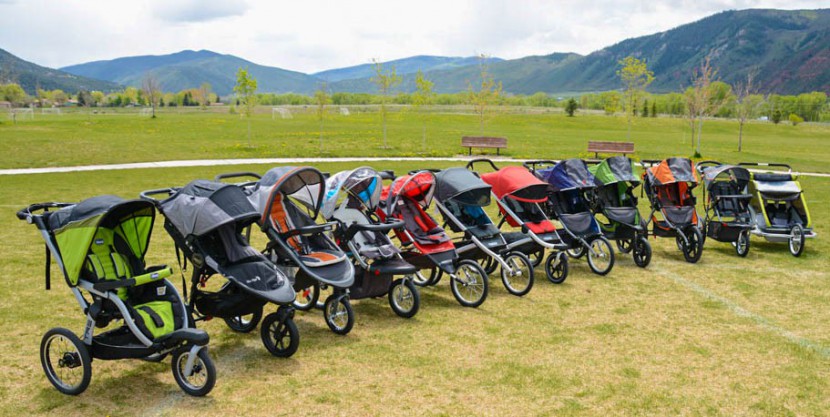Run-ability
Run-ability tests included rating the strollers for their handlebar shape and adjustability, their rolling resistance distance in our tests, how well they tracked, whether they offered adjustable tracking, and how well the tracking worked. We took all of the strollers running with multiple testers on different surfaces. We assessed how difficult it is to push them, whether they are easy to run with or a wrestling nightmare, and how much fatigue we felt from one stroller to another.
Our run-ability testing influences the overall score more than any other metric. Because we assume users are choosing this style of stroller because they plan to run with it, this metric felt like the most important consideration for our readers.
Ease of Use
Testing ease of use required that we compare the features of each product and how easy they were to use under normal circumstances. Some of the conveniences looked good on paper but weren't useful in real life, and other features seem almost useless for a stroller you plan to run with. Strollers with ample and useful storage, with features like organizing pockets or covers scored higher. Harnesses with easy adjustments and padding also got a bump in scoring. We also assessed the brakes, how well they work, and how easy they are to set or release. Plus, we folded and unfolded every single stroller over and over because once you've stood crying in a parking lot with a stroller you can't fold, you never forget it.
Some of the strollers don't have many conveniences like those you might find on a traditional stroller, and unlike other types of strollers, we don't consider this to be a downfall. Products designed for running don't necessarily need a lot of bells and whistles, and having too many means, it might be challenging to use them when you are jogging. However, we feel if they are going to have the features, they should be done well, highly functional, good quality, and easy to utilize. We compared strollers against one another so parents could get a feel for which options were better than others.
For harnesses, we assessed how easy they were to get on and adjust and how difficult it was to get a proper fit for smaller babies. If a harness is hard to use, parents might neglect using it; if it is too easy, children might be able to “get out of it” when parents aren't looking. Products earned more points if they were easy to adjust and use.
We gave more points to single-action brakes over double-action brakes because we believe they are easier to use and more likely to be appropriately set.
Ease of Setup
We timed how long it took to get the products out of the box and ready to run using the instructions provided in the box. Products earned more points for taking less time, having easy-to-read manuals, no tool assembly, and photos or illustrations. They lost points for clumping together multi-language instructions that take longer to read, pictures or steps unnecessary for construction, and hard-to-follow or unclear instructions. The most straightforward products to assemble have clear text and helpful images, and the majority of the product is already assembled.
Maneuverability
We put all of the strollers through a series of tests on different surfaces and multiple environments to determine their maneuverability and stability during use for their intended purposes. We jogged with them two-handed and one-handed, over flat hard surfaces, across the grass, dirt, and gravel, and manage stairs and curbs to determine which products were up to the challenge. The critical part of being a jogging product is moving well in tight spaces and various terrains at speed. Navigating on hard surfaces is a must; moving at speed is just as important. While the design of these products is for stability when running, it is also useful if they can move in tighter places without bumping into obstacles. We scored each stroller against each other based on which did the best moving through our obstacle course and real-life scenarios. The strollers that were easy to turn earned higher marks, the fixed wheel options that required less tipping or were shorter in length scored better than those that were hard to tip or knocked into things when turning.
Transporting and Storing
For weight and folded size, we measured each product instead of relying on manufacturer specs. We wanted to ensure that all the products were rated using the same scale for weight and the same measuring methods. We weigh the strollers fully assembled with all their parts and measure them with the same device by the same person. The values were then compared to each other and ranked. The smaller, lighter joggers earned more points in this metric, though the overall scores were weighted less in the overall scoring than in different stroller categories like umbrella products. While all jogging strollers are bulky and weigh more than other styles, there are some that are smaller and easier to fold and lift.
Quality
We base quality on our overall experience and how the materials and fit and finish of each stroller compare to each other. For fabric, we gave points for the weave, stain, or water-repellent properties, snag-ability, straight stitching, and how it attached to the frame. We reviewed the frame materials, hinge points, connectors, and if the frame flexed or the handlebars wobbled. We also compared the wheels of each product and how well they connected to the stroller. We assess quality by comparing each stroller and how well they held up after their brief period during testing.

